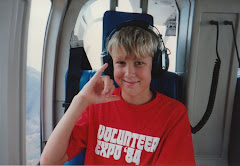I'm fairly comfortable flying the machine straight-and-level now, so I was able to glance around a bit and take in the view as I flew. I felt wonderfully relaxed as we cruised lazily south in smooth air 1500 feet above dark lava fields.
For safety, we traveled over a lone highway that bisected the lava below; in helicopters, you always want a safe landing spot in sight, and the broken volcanic rubble was not very inviting.
After some time without any conversation, Grant prompted me for the wind direction, gently testing me on what pilots call "situational awareness." We discussed various wind indicators and agreed on a general direction.
"Do you have a spot in sight?" he asked. I was puzzled by this needless question. Obviously the highway was our spot; we were intentionally following it, and there was not much else but rugged lava.
"Sure. The highway," I said, wondering exactly how stupid he thought I was.
"Ok. Engine failure," he said, and cut the throttle.
Now here's the thing. If a helicopter experiences catastrophic engine failure, the pilot has a few seconds -- like maybe three -- to initiate autorotation, or else the rotor stalls and you fall from the sky like a stone.
"Fuuuckkk!" I exclaimed, utterly stunned.
It was already over. Grant had taken the controls and initiated the autorotation for me. My brain sputtered and sizzled, grasping to cope with an onslaught of stimuli.
"You got it," he said -- our phrase for exchanging controls -- and I reflexively took it back, my synapses surging into action. I won't bother re-listing all the things a pilot has to process in autorotation, but I will say the experience was like being suddenly wrenched from sleep by a bucket of ice water, a blaring freight train, and a pack of rapidly advancing blood-thirsty hyenas.
 I managed to get a grip on myself and keep the helicopter under control in the descent. We coasted down to within a few hundred feet of the highway, re-engaged the engine, and then gradually resumed our altitude and course.
I managed to get a grip on myself and keep the helicopter under control in the descent. We coasted down to within a few hundred feet of the highway, re-engaged the engine, and then gradually resumed our altitude and course.My thundering pulse eventually eased, but I was mentally rattled for the rest of the flight. If I'd been alone, I would have been dead. It was a very effective lesson. You must always be ready. Always.




No comments:
Post a Comment